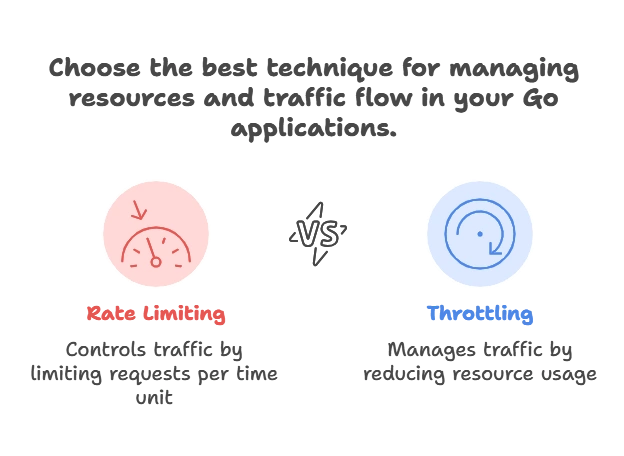Rate Limiting and Throttling
In software development, especially when dealing with networked services, it's crucial to control the rate at which certain operations are performed. This is where rate limiting and throttling come into play. Rate limiting sets a maximum number of requests or operations that can be performed within a specific time window, while throttling controls the flow of requests to a certain rate. In this chapter, we'll delve into implementing rate limiting and throttling mechanisms in Go, exploring both basic concepts and advanced techniques.
Understanding Rate Limiting
Rate limiting involves restricting the number of operations or requests that can be performed within a given timeframe. This prevents servers from being overwhelmed by too many requests at once, ensuring a more stable and reliable system.
Basic Concepts
Rate Limiting Parameters:
- Rate: The maximum number of operations allowed per unit of time.
- Burst: The maximum number of operations allowed to burst above the rate temporarily.
Token Bucket Algorithm:
- In this algorithm, a token bucket is used to control the rate of requests.
- Tokens are added to the bucket at a fixed rate.
- Each request consumes a token from the bucket.
- If there are no tokens available, the request is delayed or rejected.
package main
import (
"fmt"
"time"
)
func main() {
// Initialize a token bucket with a rate of 10 tokens per second
tokens := make(chan struct{}, 10)
go func() {
for {
tokens <- struct{}{}
time.Sleep(time.Second / 10)
}
}()
// Simulate requests
for i := 0; i < 20; i++ {
<-tokens // Consume a token
fmt.Println("Request processed:", i+1)
}
}
Advantages of Rate Limiting:
- Prevents server overload.
- Protects against abuse or malicious attacks.
- Ensures fair resource allocation.
Understanding Throttling
Basic Concepts
Types of Throttling:
- Bandwidth Throttling: Limits the data transfer rate.
- Request Throttling: Limits the number of requests per unit of time.
Leaky Bucket Algorithm:
- Requests are placed in a bucket.
- The bucket has a maximum capacity, and requests overflow if it’s full.
- Requests are processed at a fixed rate, leaking out of the bucket.
package main
import (
"fmt"
"time"
)
func main() {
// Throttle requests to 3 per second
throttle := time.Tick(time.Second / 3)
// Simulate requests
for i := 0; i < 10; i++ {
<-throttle // Wait for next available slot
fmt.Println("Request processed:", i+1)
}
}
Advantages of Throttling:
- Prevents sudden spikes in traffic.
- Protects against service degradation.
- Helps maintain system stability.

Rate limiting and throttling are essential techniques for managing resources and controlling traffic flow in distributed systems. By implementing these mechanisms in Go, developers can ensure their applications remain responsive, scalable, and resilient under varying loads. Understanding the underlying algorithms and best practices empowers developers to build more robust and efficient systems. Happy coding !❤️
